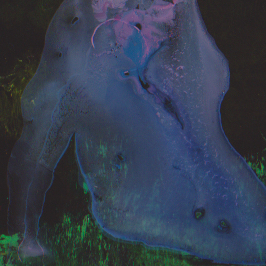‘The plane surface is the one that a ruler, placed on any part of it, adheres to it in a uniform way; the surface of perfectly clear and calm water will be most similar to this.’
Leon Battista Alberti, On painting
Benjamin Deffossez’s painting is well of his time ; it actually echoes with others, and conversely — no anteriority here, nor Who might have found first the new Colombian egg. “Being of one’s time” means a fresh painting, which does not keep trotting out what is long acquired for 120 years, but which, rather, tends bravely to “vocabularize” these days of ours. Défossez’s paintings are discreetely narrative and enactively subjective; they have recourse to subjects and context; an ambient context.

Défossez affectionates sharply contrasted bright lightings, and deep black. Above is a good exemple of an illustration between strangeness and almost shapeless, solidity and liquefaction. Facing up with a painted work, there is, since Goya at least, an iconic supplement which we could call, after Henri Focillon, the life of forms (1934), for instance Goya 1786

Focillon:“Form can become formula and canon, meaning, the abrupt stop, model type, but first it is a moving life in a changing world.” Does Défossez reread this sentence before painting? Or did Focillon wrote it after having seen “things” in which viscosity was in process? Viscosity: ‘a measure of the resistance of a fluid to flow’ (Chambers). See, in the image of the painting ↑ this blue shape, with exotic flower necklace. Is she on the way to give up on viscosity? We can beg the question. Meanwhile, some undetermine shape climbs up the tree, not exempt of martian strangeness either, as much as the soil (before we knew it was red).
Focus:

Body within body. It gets complicated. Theory of the homunculus (?) Here, it’s as if there was fom on form, form-itself under form; how to say? Something strange is happening in this body, and, to tell the truth, I cannot reach any explanation.

There is an assumed fictional dimension in Défossez’s paintings, and this, in another aera, evokes for me some drawings by Corentin Grossmann, either gifted with some fictional potentiality. It’s not that much obvious to produce some visual fictional work — a vast topic —, let us say that most of artists do not add this second or third level either of reading as much as representation; for many reasons, notably because many take themselves very seriously, while some others still naïve on the question of representation. The fictionalizing artists are serious enough, but fictionalizing allows a step aside, a move back, which favours questioning, such as: What do I see? and What is there to understand? Here above, it’s parlant. Like a landscape on a tray. But, once in position to catch this landscape-tray, we see that another one detaches in the background. Notice the launch of this luminous being, the leaving of a body, the theme of emanation which we find again in other paintings, such here:

A corpse, decomposing, still floating, with this pretty emanation — (1680s, “to flow out”, from Latin emanatus, past participle of emanare “flow out”, figuratively “arise from, proceed from”) — in a christmas tree fashion. Feast of the Dead. Away from anything, in this pond hemed with green. Allbw. Exit.

This emanates, towards up, and down

Benjamin Défossez writes me that he paints with a very diluted acrylic, horizontally, because if he was vertically painting, everything would run to the floor.
PS. The reader will have noticed the modest dimensions of Défossez’s paintings. I’ve asked him about it, and he answered to me that these very dimensions allow him to keep track of the visual field. Another question concerns the medium, i.e, wood. Once again, I’ve asked him about this, when most of the painters use canvas. The answer is that he paints on wood since the beginning :“There are at least two reasons with my small formats pratice. First, it is linked to technique. I often use a very diluted and liquid paint which make me paint on flat position. I let the paint go diffusing and slide on the format but I cannot encourage saggings because if I’d paint vertically the paint would go straight on the floor”. He started with “debris found in the street”. The attempts on canvas did not provide the comfort he needs : “the rigidity of the medium allows a firmer anchoring, a more concrete start, the brush does not drive in and I need this rigidity to reassure me on the behaviour on my painting, which builds itself layer by layer, just as a scale model”(email conversation).
1430. This is the date from which, according to the historian Hans Belting, we can talk about ‘painting’ as an autonomous genre (whereas, until then, the activity of the painter was decomposed in diverse works such as decor, from churches to coat of arms, among other tasks. What was the first medium of these paintings? Wood. Although canvases appeared as soon as 1410, yet anecdotally, the majority of artists will have continued to paint on wood until the 17th century.

PS. Every painting by Défossez is entitled “Tentative”, i.e., attempt. It’s a way of blocking any interpretation, for the onlooker and, for the artist, to re-incite the again and again, the work, says he.
Note. Alberti firstly wrote his De Pictura in latin, where it reads : Quid est enim aliud pingere quam arte superficiem illam fontis [fountain] amplecti ?’ In Éric Méchoulan, “Des origines de la peinture”, Protée, Vol. 28, numéro 1, 2000
Refs. Hans Belting, Miroir du monde : L’invention du tableau dans les pays bas, Hazan, 2014 /// Leon Battista Alberti, On Painting, Cambridge UP, 2013
Léon Mychkine
![]()
mychkine@orange.fr

